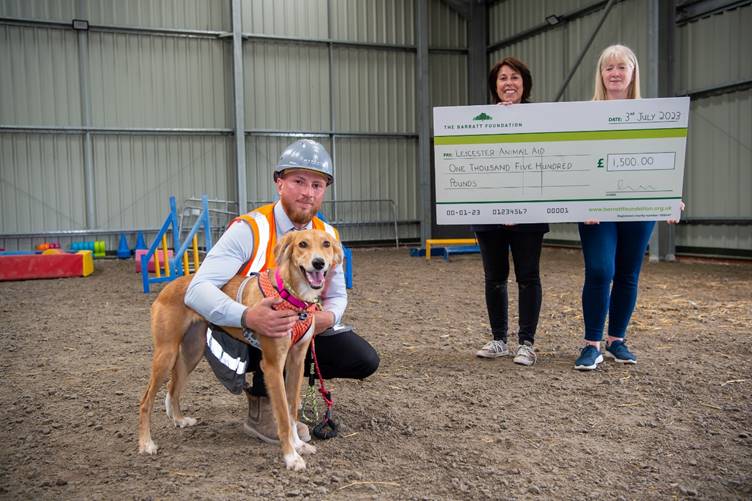LEICESTERSHIRE HOMEBUILDER RAISES THE ‘WOOF’ WITH ANIMAL CENTRE DONATION

Leading developer Barratt Homes has made a £1,500 donation to an animal rehoming centre in Huncote as part of its Community Fund scheme.
Leicester Animal Aid, based in the South Leicestershire village of Huncote, cares for around 300 dogs and cats who are lost, abandoned, neglected, unwanted or relinquished each year and the contribution from the housebuilder will help its services.
The cost-of-living crisis has taken its toll on many people with pets and, as reported by Pets4Homes, one in 10 UK pet owners are considering giving up their companion to cope with financial pressures. It was noted that 18% of owners were falling into debt to pay for their pets’ care, whilst 25% said they will not take their pet to the vet due to high costs.
In addition, there are also other reasons why well-loved pets are relinquished and this is where charities like Leicester Animal Aid make a real difference. The funding from Barratt Homes has gone towards the Community Pet Support Scheme, which helps elderly, disabled and housebound pet owners care for their companion animals at home.
Helen Wilber, Fundraising Manager at Leicester Animal Aid, said: “When we received the news of the donation, we were absolutely delighted.
“Our Community Pet Support Scheme not only helps local people, but it helps to prevent well-loved animals being relinquished because their owners are elderly or have disabilities which are impacting on their ability to look after their animals in the way they would like to.
“The charity relies heavily on donations from kind, individual and sympathetic, local and national businesses to keep our doors open to cats and dogs who need a second chance, so we are always grateful for any assistance.”
The donation was made as part of the housebuilder’s Barratt Developments Plc Charitable Foundation, which is designed to support national and local charities, large and small, leaving a lasting legacy in the communities in the areas the developer is operating in.
During the pandemic, and since the end of lockdown, Leicester Animal Aid has taken in more young dogs than usual. The registered charity has also had more dogs that have not had the opportunity to socialise with other dogs and people due to the isolation periods, and ones which haven’t received the basic training they need.
As a result, the dogs have needed more extensive care plans to help build their confidence, social and behavioural skills.
On the relinquishment side, many owners giving up animals have acknowledged that they have found pet ownership challenging. Some owners have explained that they were unable to register their new pet at a veterinary practice, and have struggled to book and afford routine care such as vaccinations, and neuter or spay surgery. To combat this, the charity has cared for more pregnant cats and unwanted younger cats than usual, and also had a higher number of cats requiring veterinary treatment.
The work of rehoming charities has increased in the past year due to pets that were adopted during the lockdown periods being returned, largely due to the cost-of-living crisis. Pets charity, Woodgreen, stated applications to adopt animals had plunged from around 10,000 during the lockdowns to now hundreds a month.
Mark Cotes, Managing Director at Barratt Homes North Midlands, said: “The work of Leicester Animal Aid is of extreme importance, as there are many dogs and cats in need of a loving home.
“The charity’s efforts to care for pets in need is fantastic to see, and we’re glad to see our Community Fund donation will be put to good use via the Community Pet Support Scheme.”
To learn more about the charity, visit its website at Leicester Animal Aid.
For more information about any nearby developments, visit Barratt Homes in Leicestershire.






